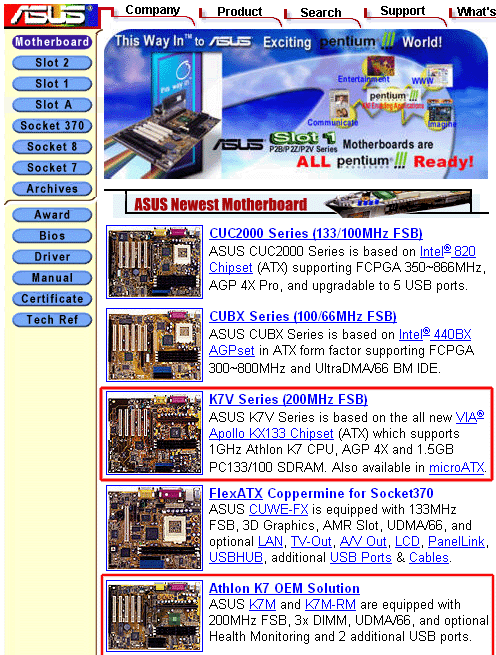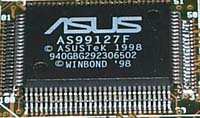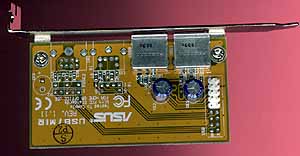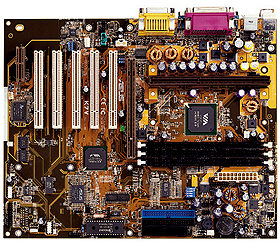
Original Link: https://www.anandtech.com/show/521
Not too long ago we took a look at ASUS' first KX133 based Athlon solution, the K7V-RM. The K7V-RM left us with a very positive feeling towards ASUS' contribution to the Athlon motherboard market. The board was extremely stable, an argument verified by AMD as the K7V-RM was one of the first two motherboards to become certified for 1GHz operation and had just about every feature we could ask for on a KX133 board.
The unfortunate downside to the K7V-RM was that it was a microATX solution geared towards the OEM market, not towards the PC hardware enthusiast market that we tailor to. Luckily ASUS wasn't going to cripple their KX133 line by only releasing a microATX version of the board and a full ATX version of the K7V-RM, dubbed the K7V, was due out for release shortly after the K7V-RM.
We definitely had some very high hopes for the K7V because, if it was to be anything like the K7V-RM then it would surely turn out to be one of the best if not the best ATX KX133 motherboard for Athlon owners. One of the biggest fears that we had about the K7V wasn't related to it being able to live up to our expectations (ASUS would really have to screw up the design in order for the K7V to be that different from the K7V-RM), but rather, we were worried that ASUS would once again take the route of the K7M and blatantly deny the existence of the K7V as a member of their product line.
To our relief we, as well as a number of satisfied Athlon owners can now see the K7M line of Athlon motherboards as well as the new K7V and K7V-RM boards listed on ASUS' latest motherboards page as official ASUS products. The K7V and K7V-RM are also going to be sold in official ASUS boxes, not the white OEM boxes that the first K7Ms were sold in, which was a little more than just peculiar.

So does the K7V measure up to the expectations that we had for it after testing its microATX sibling? In one word, yes.
|
Motherboard Specifications |
|
| CPU Interface |
Slot-A
|
| Chipset |
VIA KX133
VIA 371 North Bridge VIA 686A South Bridge |
| L2 Cache |
N/A (on-chip)
|
| Form Factor |
ATX
|
| Bus Speeds |
90 / 92 / 95 / 97 / 100 / 101 / 103
/ 105 / 107
110 / 112 / 115 / 117 / 120 / 122 / 124 / 127 / 130 133 / 136 / 140 / 145 / 150 / 155 |
| Voltages Supported |
1.30v - 2.05v (in 0.05v increments)
|
| Memory Slots |
3 168-pin DIMM Slots
|
| Expansion Slots |
1 AMR Slot
1 AGP Pro Slot 5 PCI Slots (5 Full Length) 0 ISA Slots |
| AC'97 |
Cirrus Logic CS4299 CrystalClear
SoundFusion
|
| BIOS |
AWARD Medallion BIOS v6.00
|
The Good
Just as the K7V-RM was the successor to the K7M-RM, the K7V, it's ATX brother, is the successor to the extremely popular K7M, which was based on the old AMD 750 chipset. As we mentioned at the start of the review, the microATX K7V-RM wasn't exactly ideal for the PC hardware enthusiast market that comprises the majority of our readers, but it was perfect for not only OEMs looking to build more flexible systems but also end users that are happy with only 3 PCI slots.
Like the AOpen AK72, the K7V is built upon an oversized PCB that closely resembles an extended ATX form factor motherboard. The K7V can be added to the list including the FIC SD-11 and the aforementioned AK72 that are built on these larger PCBs, and although it may be easier to work with a motherboard that features a larger PCB, it isn't a positive feature from an installation standpoint as the larger boards can get quite cramped in your average mid-tower ATX case. If you happen to have a larger tower then you shouldn't have anything to worry about, but be warned that the K7V is about an inch (2.54cm) deeper than the K7M and most other ATX Athlon boards.
What makes the K7V series of boards different from the older K7M series is that these boards use VIA's KX133 chipset, which has just recently started appearing in motherboards on the market. Located between the Slot-A connector and the memory banks is the KX133's North Bridge. The 371 North Bridge brings the main features of the KX133 to the table: 133MHz memory bus and AGP 4X support. The beauty of the 371's memory controller is that it can run your memory at either 133MHz or 100MHz using a multiplier of the FSB frequency. So those users with PC133 SDRAM can take advantage of the increased bandwidth (1.06GB/s vs. 800MB/s) over PC100 SDRAM, while allowing backwards compatibility with older PC100 SDRAM. While the memory controller boasts support for Virtual Channel SDRAM, we have yet to see a real reason for upgrading to VC100/VC133 SDRAM since the performance improvement over regular PC100/PC133 SDRAM is negligible in real world situations, which doesn't justify the price premium that you currently have to pay for it.
The K7V, as is the case with most Athlon motherboards, features 3 DIMM slots capable of accepting PC100/PC133 or VC100/VC133 SDRAM running at either a 3:3 (1:1) ratio with the FSB (by default, 100MHz) or a 4:3 ratio with the FSB (133MHz by default). Although the K7V does feature a large PCB, the memory slots were luckily placed away from the edge of the board, which limits their interference with hard drive bays in more cramped cases.
The board does improve on a major layout problem that was present with the K7M: the ATX power supply connector is now placed on the opposite side of the memory banks so that it doesn't interfere with the installation of any larger heatsink/fan combos. While the amount of room present between the Slot-A connector and the memory banks isn't tremendous, at least the area you have to work with isn't obstructed.
Following VIA's recommendations as well as the lead of every single KX133 motherboard manufacturer to date, ASUS outfitted the K7V with VIA's 686A Super South Bridge that features an integrated I/O controller as well as an integrated PCI-ISA bridge, AC/MC'97 and hardware monitoring controllers. The beauty of the 686A Super South Bridge as we know from previous KX133 and Apollo Pro 133A reviews is that by integrating all of these functions into a single chip motherboard, manufacturers can save PCB space since they don't have to place more chips on the board. In the case of the K7V, with an already large PCB, the space saving benefits of the 686A are negated.
 Another
one of the benefits of the 686A is rendered useless by the on-board ASUS AS99127F
ASIC for hardware monitoring that can monitor 3 temperatures, 3 fan speeds,
and 6 voltages. ASUS included an external thermistor header by the Slot-A connector,
but supplied no thermistor for use with it. It would've made much more sense
for ASUS to use the cheaper 596B South Bridge controller if they were going
to use their own hardware monitoring controller and forego using a smaller PCB
for the board.
Another
one of the benefits of the 686A is rendered useless by the on-board ASUS AS99127F
ASIC for hardware monitoring that can monitor 3 temperatures, 3 fan speeds,
and 6 voltages. ASUS included an external thermistor header by the Slot-A connector,
but supplied no thermistor for use with it. It would've made much more sense
for ASUS to use the cheaper 596B South Bridge controller if they were going
to use their own hardware monitoring controller and forego using a smaller PCB
for the board.
One feature of the 686A Super South Bridge that was used is its support for 4 USB ports, as ASUS supplies an extra two USB connectors right out of the K7V's box.
The biggest issue we had with the K7V-RM was, because of its microATX form factor, the possibilities for expansion were very limited. The board itself featured no more than 3 PCI slots, an AGP slot and an AMR slot. The K7V builds upon its microATX counterpart's expandability by offering two more PCI slots, bringing the total up to 5 PCI slots, all of which are capable of accepting full length cards (if that doesn't seem important to you now, just wait until the release of the PCI Voodoo4/5 cards from 3dfx).
 In
addition to those five PCI slots, the board features the AMR slot which is driven
by the 686A Super South Bridge and an AGP Pro50 slot that has been popping up
on virtually all of the newer ASUS motherboards. While we have yet to see any
widely available video cards take advantage of the 25 - 50W AGP Pro50 specification,
having the slot doesn't harm anyone, and ASUS even went to the trouble of blocking
off the first 20 pins of the slot to prevent the accidental insertion of a regular
AGP card into the wrong section of the slot. Doing so would probably end up
frying your card since those upper 20 pins are mainly additional power pins,
so it's a well-needed safety precaution on ASUS' part.
In
addition to those five PCI slots, the board features the AMR slot which is driven
by the 686A Super South Bridge and an AGP Pro50 slot that has been popping up
on virtually all of the newer ASUS motherboards. While we have yet to see any
widely available video cards take advantage of the 25 - 50W AGP Pro50 specification,
having the slot doesn't harm anyone, and ASUS even went to the trouble of blocking
off the first 20 pins of the slot to prevent the accidental insertion of a regular
AGP card into the wrong section of the slot. Doing so would probably end up
frying your card since those upper 20 pins are mainly additional power pins,
so it's a well-needed safety precaution on ASUS' part.
The K7V, like the K7V-RM, features the Cirrus Logic CrystalClear SoundFusion CS4299 AC'97 codec that provides the CPU driven sound on-board. Luckily, the sound can be disabled from within the AWARD BIOS setup, but for system integrators, the software audio option makes for an easy way to include audio support for their low-cost systems. In terms of quality and performance, most AnandTech readers won't be too flattered by the integrated codec and will opt to use one of the three PCI slots for their own PCI sound card, but if this board is going to be the base for a second system then the integrated sound could save you a few bucks.
In order to supply a stable signal to the Athlon (something that is critical to the stable operation of any Athlon system since the Athlon draws so much power), ASUS outfitted the K7V with a handful of 1500uF and 680uF capacitors and even an oversized 4700uF cap.
Speaking of stability, the K7V was the most stable KX133 motherboard we've tested to date. It even outperformed the K7V-RM in our stability tests. While that was most likely due to the K7V-RM being an engineering sample, while our K7V is an actual retail board, the stability of the board is second to none.
Just like the previous Athlon motherboards from ASUS, the K7V features quite a few options for overclocking including support for a fairly wide range of FSB frequencies: 90 / 92 / 95 / 97 / 100 / 101 / 103 / 105 / 107 / 110 / 112 / 115 / 117 / 120 / 122 / 124 / 127 / 130 / 133 / 136 / 140 / 145 / 150 / 155MHz. Out of those, only the settings under 117MHz were of any use during our tests since anything higher wouldn't so much as boot. This isn't abnormal since it seems to be a limitation of the current implementation of the Athlon's EV6 bus by motherboard manufacturers.
The BIOS setup also allows you to set the DRAM to CPU frequency ratio as either 3:3 or 4:3, thus allowing you to run your memory at 133MHz while your FSB runs at 100MHz. In addition to FSB selection, the AWARD Medallion BIOS of the K7V lets you manually adjust the core voltage of your CPU, making the board even more flexible for overclockers. Both the FSB selection and core voltage selection can be accomplished through jumpers and dip switches located on the motherboard itself.
To top it all off, the K7V ships with a fairly detailed user's manual and a driver/utility CD that contains all of the drivers necessary to get your system up and running properly the first time.
The Bad
The only real complaint we had about this board was the size of the PCB. We would've appreciated something more along the lines of the older K7M's size.
The integrated sound is always a disappointment for most hardware enthusiasts; luckily, it can be disabled, but unfortunately, if you want to use your own sound card, you'll be taking up one of the five available PCI slots leaving a four more for expansion. But this gets back to the initial problem most users will have with the motherboard.
The K7V makes use of what AWARD calls the Medallion BIOS Setup, which is nothing more than the old Phoenix BIOS Setup that was created after Phoenix took over AWARD. In spite of this scary fact (the Phoenix BIOS setup has never been our favorite), the setup does allow for all of the options that we'd normally find in an AWARD setup, so we can't really complain.
USB Compatibility
-
Number of Front Universal Serial Bus Root Ports: 2
-
Number of Rear Universal Serial Bus Root Ports: 2
-
USB IRQ Enable/Disable in BIOS: Yes
-
USB Keyboard Support in BIOS: Yes
Recommended SDRAM
Recommended SDRAM: 1 x 128MB Corsair PC133 SDRAM; 1 x 128MB Mushkin PC133 SDRAM
SDRAM Tested: 1 x 128MB Corsair PC133 SDRAM; 1 x 128MB Mushkin PC133 SDRAM
Manufacturer:
Corsair
Purchase Website: http://www.corsairmicro.com
Manufacturer:
Mushkin
Purchase Website: http://www.mushkin.com
The Test
In recent times, choosing a motherboard cannot be completely determined by a Winstone score. Now, many boards come within one Winstone point of each other and therefore the need to benchmark boards against each other falls. Therefore you shouldn't base your decision entirely on the benchmarks you see here, but also on the technical features and advantages of this particular board, seeing as that will probably make the greatest difference in your overall experience.
Click Here to learn about AnandTech's Motherboard Testing Methodology.
|
Test Configuration |
|
| Processor(s): |
AMD
Athlon 800
|
| RAM: |
1
x 128MB Corsair PC133 SDRAM
1 x 128MB Mushkin PC133 SDRAM |
| Hard Drive(s): |
Western Digital 153BA Ultra
ATA 66 7200 RPM
|
| Bus Master Drivers: |
VIA 4-in-1 v4.16 BMIDE Driver
|
| Video Card(s): |
NVIDIA
GeForce 256 SDR
|
| Video Drivers: |
NVIDIA
Detonator 3.76
|
| Operation System(s): |
Windows
98 SE
|
| Motherboard Revision: |
ASUS
K7V Revision 1.01
|
|
Windows 98 Performance |
||
|
Sysmark
2000
|
Content
Creation
Winstone 2000 |
|
| ASUS K7V - Athlon 800 (KX133) |
154
|
32.2
|
| AOpen AK72 - Athlon 800 (KX133) |
148
|
30.4
|
| MSI
K7Pro - Athlon 800 (AMD 750 SuperBypass Enabled) |
153
|
30.4
|
| Gigabyte
GA-7IX - Athlon 800 (AMD 750 SuperBypass Enabled) |
154
|
30.7
|
| EPoX 7KXA - Athlon 800 (KX133) |
152
|
30.6
|
| ASUS K7V-RM - Athlon 800 (KX133) |
152
|
30.6
|
For more benchmarks visit our KX133 Review and our Athlon 1GHz Review
The Final Decision
If you're looking for a new KX133 board and the large PCB doesn't bother you, then the K7V is definitely the board to get. In spite of ABIT's forthcoming KA7 release, it is doubtful that the K7V will be bested anytime soon by upcoming KX133 boards. Remember that there is much more that matters outside of having a huge list of available FSB frequencies. We will be looking at the KA7 shortly and will be able to give the final verdict for sure once we complete our testing.
For current AMD 750 owners, there isn't a real reason to upgrade to the K7V unless you have some cash to kill and are currently having problems with your motherboard. As we illustrated in our KX133 Review, the performance advantage the KX133 chipset holds over the AMD 750 chipset (with SuperBypass enabled) is not noticeable in most situations, although users of high-end 3D applications may find the performance benefits of the KX133 definitely worthy of a quick $150 investment in the board.
The bottom line is this, if you want a KX133 board, the K7V is the one to get. Although we'd like to give ASUS the Editor's Choice Award right now, we're going to hold off on judgement until our next Athlon Motherboard Roundup before giving out any awards.
How it Rates
|
AnandTech Motherboard Rating |
|
|
Rating
(x/10)
|
|
|
Performance
|
5.5
|
|
Price
|
4.5
|
|
Stability
|
8.5
|
|
Quality
|
8.0
|
|
Features
|
6.5
|
|
Layout
|
4.0
|
|
Availability
|
8.5
|
|
Documentation & Software Bundle
|
7.5
|
| Overall Rating - Not an Average - Click here to find out why |
8.5
|








